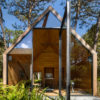The history of architecture is full of rules, theses and theories
about good architecture. The best-known are certainly
the oldest of the Roman architect and author of the «Ten
Books on Architecture», published around 20 B.C. The Vitruvian
categories firmitas (strength), utilitas (usefulness)
and venustas (beauty) have not lost their validity to this
day and are also in the ten theses of the German industrial
designer Dieter Rams, which we are talking about here.
To this end, let’s first introduce the author of these theses.
Can architects learn from designers? Usually it has been the other way around. Postmodernism even spoke of microarchitectures in design. However, the industrial designer Dieter Rams has put forward ten theses for a good design that are absolutely worthy of architects’ consideration.
Dieter Rams
Rams, born in Wiesbaden in 1932, is best known as the
chief designer of the electrical appliance manufacturer
Braun. In 1955, he triggered a kind of design revolution
when he launched white, function-oriented, clearly designed
radio sets that left the polished wooden chassis with
gold trim behind. Initially, the legendary HfG Ulm was
involved, and the best-known product of the early days
was the SK 4 radio-phono combination with a transparent
acrylic glass lid, which soon went down in design history
as «Snow White’s Cofin». Their fathers, Dieter Rams and
Hans Gugelot, were not either of them industrial designers,
but architects. Dieter Rams had studied architecture
and interior design at the Wiesbaden Werkkunstschule
and initially worked in Otto Apel’s office in Frankfurt on
the US Consulates General. Here he also met Skidmore,
Owings and Merrill from Chicago, who impressed him
in no small way. It was more by chance that he came to
Braun as an architect and then, after a short time, to industrial
design, because it was recognised that only an
in-house design department was in a position to produce
something really new in close coordination with technology.
Dieter Rams always designed with a 6B pencil on an architect’s roll, mostly at right angles and with precisely designed details. Today, he is regarded as one of the world’s most influential industrial designers of the 20th century, to whom not least Jony Ive of Apple has referred. The designer Rams has created over 350 products for Braun, the furniture manufacturer Vitsoe as well as several other companies, all of which exhibit a common and stringent design language, but form anything but a schematic style.
Dieter Rams always designed with a 6B pencil on an architect’s roll, mostly at right angles and with precisely designed details. Today, he is regarded as one of the world’s most influential industrial designers of the 20th century, to whom not least Jony Ive of Apple has referred. The designer Rams has created over 350 products for Braun, the furniture manufacturer Vitsoe as well as several other companies, all of which exhibit a common and stringent design language, but form anything but a schematic style.
Ten theses about good product design
Rams formulated his ten theses on good product design
(theses, mind you, not rules!) successively between 1975
and 1985, always insisting that they were not set in stone,
but be taken further by younger generations. The occasion
was initially to define principles within the company in
order to further develop the design attitude in the right direction.
Through his many lectures, most of which ended
with the ten theses, they became popular not only in design circles but also in the general public discussion about
the things around us. It is noteworthy that as early as the
1980s, he emphasised environmental compatibility and
sustainability. To this day, his mantra is «less, but better».
On the one hand, this reflects «Less is more», which can actually
be traced back to Peter Behrens, but was propagated
above all by Ludwig Mies van der Rohe in the USA. On
the other hand, the «less is a bore» of postmodernism, the
short-livedness of which no longer seems responsible to
him from an environmental point of view.
Braun products, on the other hand, had and still have a very long product cycle and are repairable. The MPZ 2 citrus juicer, which is still available, will even celebrate its 50th birthday in 2022 and is still unchanged in terms of design. Ram’s plea, however, is more than criticism of an «ex and hop» mentality of throwaway consumption. It is indeed that too, but above all Dieter Rams was and is concerned with higher product quality, which is ultimately not only more durable, but also more enriching. This also includes an emotional approach. His designs are not cold and forbidding, but have a fascination all of their own, convincing proportions, inventions of form, genuine detailed solutions and a subtle play of colours. It is no coincidence that there are more collectors of Braun products than of any other industrial company – apart from vintage cars.
Braun products, on the other hand, had and still have a very long product cycle and are repairable. The MPZ 2 citrus juicer, which is still available, will even celebrate its 50th birthday in 2022 and is still unchanged in terms of design. Ram’s plea, however, is more than criticism of an «ex and hop» mentality of throwaway consumption. It is indeed that too, but above all Dieter Rams was and is concerned with higher product quality, which is ultimately not only more durable, but also more enriching. This also includes an emotional approach. His designs are not cold and forbidding, but have a fascination all of their own, convincing proportions, inventions of form, genuine detailed solutions and a subtle play of colours. It is no coincidence that there are more collectors of Braun products than of any other industrial company – apart from vintage cars.
INFO
Prof. Dr. Klaus Klemp, born in Dortmund in 1954, was, until
2020, Professor for Design History and Design Theory at the Offenbach
a.M. School for Design and Curator for Design at the
Museum of Applied Art, Frankfurt a.M.; to this day, he is Director
of the Institute for Design Exchange (IDEe) at the HfG Offenbach,
board member of the Dieter and Ingeborg Rams Foundation,
on the advisory board of the Gesellschaft für Designgeschichte
und Chairman of the Ernst-May-Gesellschaft, Frankfurt a.M.; he
has produced numerous exhibitions and publications on architecture,
art and design.
Design theories as architectural theories?
To what extent can Dieter Rams’ ten theses be transferred
to architecture – I mean 1:1? Good architecture should
certainly be innovative, demonstrate new possibilities
and incorporate the latest technology. Of course, it should
also be useful, as Vitruvius demanded with his ‘utilitas’.
Beauty also has something to do with usability, with identification, emotional and cognitive access and, last but
not least, with long-lasting acceptance. And architecture
should also explain itself and not become a maze. Clear
sign functions, which make operating instructions largely
superfluous, have always been a particular strength of
Braun. Honesty? Whole armies of architectural theorists
have talked about this, from Semper’s demand for material
honesty in the 19th century to the honesty of the façade,
which promises no more than it delivers on the inside.
Unobtrusiveness is a challenge if it is not to lead to monotony.
In this respect, so-called classical modernism was
certainly more linguistically talented than the soulless
post-war modernism. And the gift of post-modern architecture
was to end forms for different types of buildings,
that make a city legible. One is reminded of Venturi’s «duck», even if you often overshoot the target. Durability,
not only in the sense of strength, but also visual endurance,
is certainly one of the most important of Dieter Rams’
theses. It is more than questionable whether office buildings
have to be demolished after 30 years in order to erect
new fashionable buildings, that don’t last much longer
either. The longevity of products and architecture is
the great environmental and resource-related challenge
of the present.
And details are not only the soul of products as the
industrial designer Charles Eames once said, but certainly
also of architecture.
Environmental friendliness results from what has been said. What remains is Dieter Rams’ final thesis: «Good design is as little design as possible. Back to the pure, the simplicity.» Every architect must answer the question of concentrating on the essentials for himself or herself.
Ultimately, it is the question of every design. Dieter Rams does not provide an instruction manual in his ten theses. He actually asks questions that every designer, whether of things or of buildings, have to answer for themselves. I think they are more topical than ever.
10 rules for good design after Rams
Version of October 1995 (slightly modified and expanded in 2002)
Good design is innovative.
The possibilities for innovation are not, by any means,
exhausted. Technological development is always offering
new opportunities for innovative design concepts that optimise
the practical value of a product. But innovative design
always develops in tandem with innovative technology,
and can never be an end in itself.
Good design makes a product useful.
A product is bought to be used. It has to satisfy certain
criteria, not only functional, but also psychological and
aesthetic. Good design emphasizes the usefulness of a
product whilst disregarding anything that could possibly
detract from it.
Good design is aesthetic.
The aesthetic quality of a product is integral to its usefulness
because products we use every day affect our personal
environment and our well-being. But only well-executed
objects can be beautiful.
Good design makes a product understandable.
It clarifies the product’s structure. Better still, it can make
the product talk. At best, it is self-explanatory.
Good design is honest.
It does not make a product appear more innovative, powerful
or valuable than it really is. It does not attempt to manipulate
the consumer with promises that cannot be kept.
Good design is unobtrusive.
Products fulfilling a purpose are like tools. They are
neither decorative objects nor works of art. Their design
should therefore be both neutral and restrained, to leave
room for the user’s self-expression.
Good design is long-lasting.
It avoids being fashionable and therefore never appears
antiquated. Unlike fashionable design, it lasts many years
– even in today’s throw-away society.
Good design is thorough down to the last detail.
Nothing must be arbitrary or left to chance. Care and accuracy
in the design process show respect towards the
user.
Good design is environmentally friendly.
The design makes an important contribution to the preservation
of the environment. It conserves resources
and minimises physical and visual pollution throughout
the lifecycle of the product.
Good design is as little design as possible.
Less, but better – because it concentrates on the essential
aspects, and the products are not burdened with non-essentials.
Back to purity, back to simplicity!

